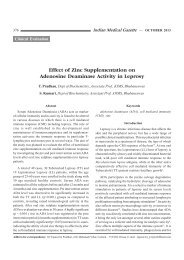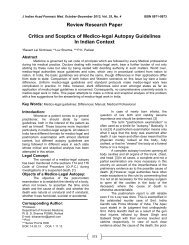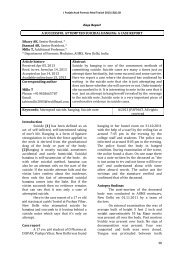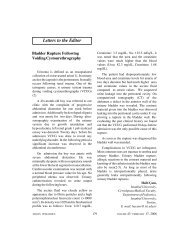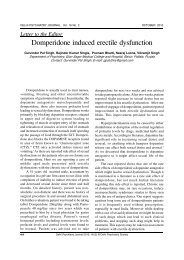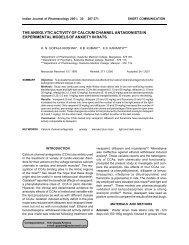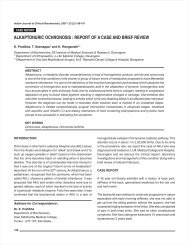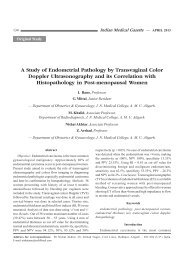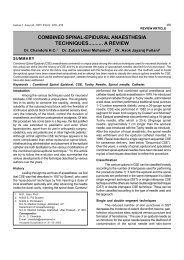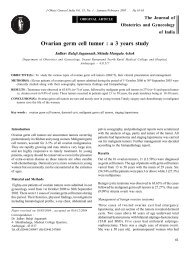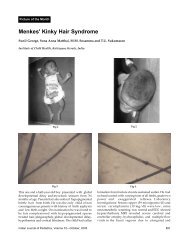You also want an ePaper? Increase the reach of your titles
YUMPU automatically turns print PDFs into web optimized ePapers that Google loves.
withdrawal movement by releasing or facilitating the<br />
‘flexion reflex synergy’ of which contraction of the<br />
extensor hallucis longus muscle forms an integral part. A<br />
Babinski sign can appear only if the intraspinal pathways<br />
of the ‘flexion reflex synergy’ are operative, however severe<br />
the motor deficit in the foot. The motor neurons of the<br />
leg muscles are laminated into separate columns within<br />
the anterior horns of the cord, each of which supply<br />
proximal or distal flexor or extensor muscles. Both<br />
structural as well as functional lesions of the pyramidal<br />
tract fibres projecting onto the lumbosacral anterior horn<br />
cells and interneurons supplying the leg muscles<br />
subserving the ‘flexion reflex synergy’ can release the<br />
Babinski sign. Reversible pathophysiologic conditions<br />
result in, or produce, a transient extensor plantar response.<br />
Structural lesions produce more lasting effects.<br />
Causes of an extensor plantar response<br />
<br />
<br />
<br />
<br />
<br />
<br />
<br />
<br />
<br />
<br />
<br />
<br />
<br />
Pyramidal tract lesions<br />
Normal children upto one year of age<br />
Deep sleep<br />
Coma<br />
General Anaesthesia<br />
Post-ictal stage of epilepsy<br />
Electroconvulsive therapy (ECT)<br />
Hypoglycaemia<br />
Alchol intoxication<br />
Narcosis<br />
Hypnosis<br />
Following severe physical exhaustion<br />
Head trauma with concussion.<br />
Types of Babinski sign<br />
<br />
<br />
<br />
True Babinski sign – includes all the components of<br />
the fully developed extensor plantar response.<br />
Minimal Babinski sign – is characterised by<br />
contraction of the hamstring muscles and the tensor<br />
fasciae latae which can be detected by palpation of<br />
the thigh.<br />
Spontaneous Babinski sign – is encountered in<br />
patients with extensive pyramidal tract lesions. Passive<br />
flexion of the hip and knee or passive extension of the<br />
<br />
<br />
<br />
knee may produce a positive Babinski sign in adults, as<br />
may foot manipulation in infants and children.<br />
Crossed extensor response/bilateral Babinski sign<br />
– may be encountered in cases with bilateral cerebral<br />
or spinal cord disease. Unilateral foot stimulation<br />
elicits a bilateral response in such cases.<br />
Tonic Babinski reflex – is characterised by a slow<br />
prolonged contraction of the toe extensors. It is<br />
encountered in patients with combined frontal lobe<br />
lesions and extrapyramidal involvement.<br />
Exaggerated Babinski sign – may take the form of<br />
a flexor or extensor spasm. Flexor spasms can occur<br />
in patients with bilateral UMN lesion at the supraspinal<br />
or spinal cord level. Extensor spasms can occur in<br />
patients with bilateral corticospinal tract lesion but<br />
preserved posterior column function.<br />
Babinski mimickers<br />
<br />
<br />
<br />
Pseudo Babinski sign<br />
Inversion of plantar reflex<br />
Withdrawal response<br />
Pseudo Babinski sign<br />
This sign may be encountered in patients with<br />
choreoathetosis where the upgoing toe is a manifestation<br />
of hyperkinesia.<br />
Inversion of the plantar reflex<br />
If the short flexors of the toe are paralysed, or the flexor<br />
tendons have been severed, an extensor plantar response<br />
may be obtained even in the absence of UMN lesions and<br />
is termed inversion of the plantar reflex of peripheral<br />
origin.<br />
Withdrawal response<br />
Most people tend to withdraw their feet from a plantar<br />
stimulus as they are unable to tolerate the sensation. This<br />
reflex withdrawal interferes with the normal response. It<br />
is basically a voluntary movement or withdrawal due to a<br />
ticklish or unpleasant sensation. It is encountered in<br />
sensitive individuals or patients with plantar<br />
hyperaesthesia due to peripheral neuritis, and can be<br />
Journal, Indian Academy of Clinical Medicine Vol. 6, No. 3 July-September, 2005 195



